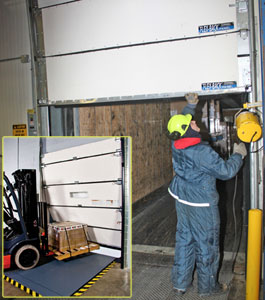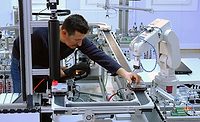Field Reports
Dock doors get some needed attention
Updated shipping and receiving doors prevent ongoing impact damage from forklifts and pallets.


|
|
Ben and Jerry’s maintenance staff replaced rigid bottom panels on its receiving dock doors with flexible FLEX-BACK panels, which give with bumps and snap back into place. (Inset photo): The processor also replaced inflexible doors on the shipping dock with CruiserWeight impactable dock doors that resist impact damage. Source: TKO Doors. |
Ben and Jerry’s makes most of its ice cream in its St. Albans, VT plant and, from that plant, ships ice cream to both the US and around the world. Not only does the 143,000-sq.-ft. plant make Ben and Jerry’s ice cream, it also produces Breyers and Good Humor brands. The facility operates three shifts through the week and shuts down the lines over the weekend for maintenance. About 1,700 pallets of product are shipped to various markets each week from the facility’s 40°F shipping dock.
All this traffic can be rough on dock equipment, especially dock doors. The plant’s entire output goes out through just four of them, so losing a single door can crimp the flow of ice cream. Plant management is not interested in a backlog stemming from downtime at the dock, so it decided to replace the existing doors with heavy-duty TKO CruiserWeight impactable dock doors. According to Fitz Fitzgerald, plant maintenance manager, “It is not uncommon for us to do 40 truckloads over three shifts.”
Any kind of bump from a forklift, no matter how slight, can affect the ability of a door to seal properly. This misalignment leads to energy-wasting gaps between the door and the door frame and make the door difficult for the dock crew to open and close. With the TKO doors, Fitzgerald and his crew found they could avoid the maintenance costs and downtime associated with the previous units, keep traffic moving and prevent the loss of chilled air at the dock.
“Our main concern,” says Fitzgerald, “is the weather seal.” Rather than mounting it on the door frame, TKO attaches the door seal gasket to the door panel, enabling it to be protected within the door guide. The gasket is never exposed to damage or tearing, according to Fitzgerald.
A high-tensile, multi-filament hinge connects the door panels, preventing energy-wasting gaps. To protect the building from energy loss, the panel’s damage-resistant polymer skin encases an insulated foam core panel that is 1 3/4 inches thick.
When space is tight at the dock, and traffic is heavy, inadvertent collisions with the doors are inevitable, but the TKO doors are designed to withstand the impacts. They use a retractable plunger guidance system that rides along the ultra-high molecular weight polycarbonate tracks, allowing the plungers to slide out of the grooved track when the door is hit. The track also withstands forklift impacts, ensuring the door continues to operate smoothly without hanging up in the track.
At the receiving dock, accidents are not as frequent or destructive. But when pallets were shoved into the existing rigid lower panels, or forklifts bumped them, they fractured. Even when the panels weren’t broken, the doors were difficult to operate and could expose the operation to insects and other invaders. Ben and Jerry’s added protection to the doors by replacing the lower panel(s) with APS Resource FLEX-BACK panels.
The FLEX-BACK panels help eliminate door panel fractures by flexing upon impact and returning to a normal operating position. “Our standard doors did not flex like these panels do,” adds Fitzgerald. “So we were replacing panels all the time. We did try other styles of replacement panels, and they, too, would eventually suffer damage and need replacement.” v
For more information: Josh Brown, 877-408-6788, sales@tkodoors.com; Joe Graf, 262-518-1000, info@apsresource.com
Looking for a reprint of this article?
From high-res PDFs to custom plaques, order your copy today!









